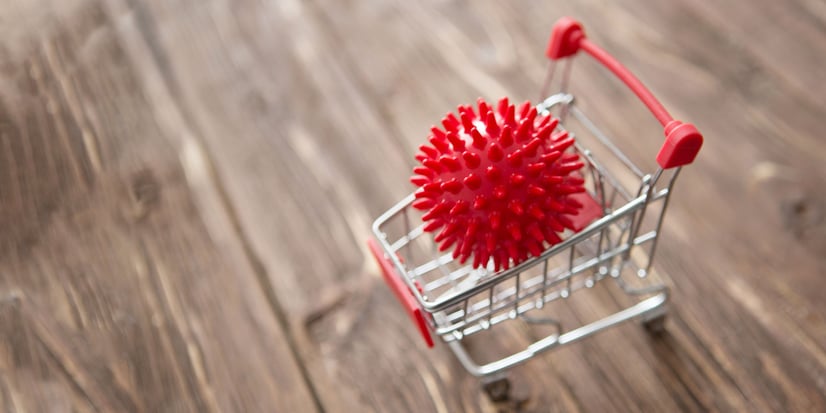7 ways the Covid-19 pandemic will transform physical retail stores long-term

The Covid-19 crisis has forced retailers to transform at a speed hardly seen before in the industry. In just a few months’ time contactless shopping and payments have become mainstream, eCommerce has become a key driver of revenue for many retailers, and new sanitation rules and protocols are now part of daily routines. Even once the pandemic subsides, we can expect some of the changes that occurred in the past few months to last, and speed up transformation.
Here are 7 key ways retail spaces have been reshaped long-term by the pandemic, and what we can expect tomorrow’s physical retail will look like.
1. Reduced staff-customer interaction
Retailers have been implementing different types of solutions to reduce the risk of transmission between employees and customers while preserving some of the social component of customer service. On the low-tech end, in many stores plexiglas dividers are now separating the cash register from customers. Some stores have installed buzzers by the register, which customers can ring to request the help of a sales assistant. Other retailers are taking a digital approach and implementing self-service solutions. Before Covid-19, customers were already starting to embrace self-service checkout technology. Today, self-checkouts facilitate contact-free shopping, while also helping reduce the risk of crowding and lines.
On the extreme end of the spectrum, automated cashierless stores drastically reduce the risk of interacting with personnel. The Amazon Go model, which uses ceiling-mounted cameras and sensors on shelves to track purchases in absence of a cashier, is now becoming more popular, and it’s being replicated by numerous technology providers. At the same time, Amazon is going in a new direction and experimenting with smart shopping carts. The idea is to equip the carts with all the technology needed to run cashierless stores without having to retrofit the entire store premises.
2. Touchless and contactless
The pandemic has significantly increased adoption for low-touch and no-touch forms of payments, such as mobile wallets and contactless cards. While these technologies were already on the rise before the pandemic hit, they got a tremendous boost due to their role in decreasing the risk of disease transmission.
Payments aside, retailers have had to find ways to deliver product information while limiting the need for customers to pick up the products. One of the most popular technological solution consists in adding QR codes and chips to the items or the shelves. Customers can scan them to view item details – from ingredients or materials, to usage advice and any other benefits – safely on their own mobile device.
3. Pick-up hubs
In April 2020, click and collect orders in the US grew 208% compared to April 2019, Adobe Analytics reports. With both in-store and curbside pickups booming worldwide during the pandemic, many retailers have had to rethink their stores’ purpose, physical design and flow, quickly adding curbside pickup areas, drive-thrus, and signage to help direct the flow of traffic. Those who were already offering in-store pickups had to rethink their approach to decrease friction and the risk of physical contact. The Holland & Barret stores in the UK have installed automated contactless click and collect drawers. When customers order a product on the eCommerce, they receive a barcode or QR code. Once their order arrives to their preferred store location, they can use this code to automatically open a drawer, without needing to interact with staff or wait in line.
Until recently, the order pick-up desk was often placed off to the side or at the end of the store, where it was hidden from the view and often hard to find. In the future, we can expect that areas dedicated to safe, contactless item pick-up will become more centrally located in stores, and that drive-thrus, delivery lockers and pick-up windows will be a core component of each retailer’s strategy for its physical locations.
4. Design that ensures distancing
Traditional retail stores are designed to draw people further inside the store, and keep them wandering about. Since the pandemic, however, the focus for both shoppers and retailers has become to make the shopping trip as quick and efficient as possible. The physical design of the spaces is changing to better help reduce crowds: stores with multiple entrances are now separating incoming from exiting visitors, with clear markings to help manage the flow, and displays are kept far apart to limit crowding. As a result, tomorrow’s stores may have to rethink their in-store selection, and display a smaller, more curated catalog. We can also expect markers that help people keep a safe distance to become part of store design. Flooring colors, fixtures and furniture may be rethought so they clearly create separate waiting, browsing and passage areas.
For many retailers, guaranteeing proper distancing is not just a legal requirement: many concerned customers will only shop if they feel it’s safe to do so. Some retailers have added digital displays that show how many people are currently inside the store, to ensure maximum capacity is not exceeded. In its UK supermarkets, Aldi has debuted a traffic light system that informs customers when they can enter safely.
5. Smaller formats
Big-box retailers like Walmart, Whole Foods and Ikea have been experimenting with small-format stores for years. Before Covid-19, the goal was to increase penetration in urban areas, to better target busy workers.
Today, with fewer people relying purely on physical locations to buy products, brands can go further with the transformation of store locations into showrooms which display a curated selection of core items. The economic incentives are worth the effort: decreasing the store’s square footage means lower costs in terms of rent, maintenance, and staffing.
In the future, we may even see a renaissance of the small town high street, as retailers re-invest the capital that used to be tied to one big box store to open several small-format locations in different areas. At the same time, we also expect to see a radical transformation in large urban areas. With office workers at home and tourists preferring weekends in the country to city breaks, it’s still unclear what shopping hotspots like London, New York City or Paris will look like tomorrow.
6. Focus on air quality and safety
A general uneasiness about closed spaced has forced retailers to rethink the traditional model of store as an air-conditioned space with lots of items and no windows.
To attract visitors and overcome crowding limitations, shops are moving outdoors. Some city councils are allowing retailers to expand to the sidewalk and in some cases even to the roads, with road closures planned to aid retail recovery. In California, US, luxury mall South Coast Plaza reopened moving its operations outdoors. This is no traditional street market: the high-end brands moved their wares to a series of open-air luxury suites, erected under a pavilion in the mall’s parking lot. “The Pavilion” can be visited by appointment only, and the booking must include details of the items the customer would like to see or try on. All suites are sanitized before and after each appointment. In the future, we can expect more outdoors malls, pop-ups and sidewalk stalls, across the entire retail spectrum.
Moving outdoors may not be an option for everyone. For retailers tied to traditional spaces, technology can help limit risk. Improved filtration and HVAC systems improve the quality of air indoors and lessen the spread of germs by reducing pollution and increasing air humidity. Hopefully, they will also reassure anxious customers that indoors shopping can be safe.
7. Scattered store visits
On a typical day a retail store may be empty for hours, to then fill up during peak times. Retailers are finding creative ways to better distribute the flow of guests throughout opening hours.
Supermarket chain Sainsbury’s has been trialing a virtual queuing system. Shoppers can keep track of their place in the queue on an app, and wait for their turn at safe distance, in a café or at the park. In Australia, Woolworths customers can use the supermarket giant’s new app to see average busy periods, track live queuing times at each store location, and even reserve a time to do their shopping. At the reserved time, customers can enter the store skipping the line.
Jewelry chain Watches of Switzerland has introduced ‘By Personal Appointment’, an online appointment service to book expert advice and consultations. Over the course of just two weeks in July, the company set 13,000 appointments. “I think a lot of that is to do with people not wanting to be out for a long time; they are out to do a job, buy what they need and then leave again,” says Craig Bolton, executive director at the group.
The Covid-19 pandemic has dramatically altered consumer habits. Retailers have adapted remarkably quickly, but the transformation has just started. To keep shoppers engaged with physical locations and overcome fears, they need to keep up the momentum, stay aligned with consumers’ wants, needs and concerns, and not be afraid to test, change, communicate what they are doing and continuously reinvent the shopping experience. If you need help to figure out how technology can help you stay relevant during times of change, contact our experts for a consultation.

